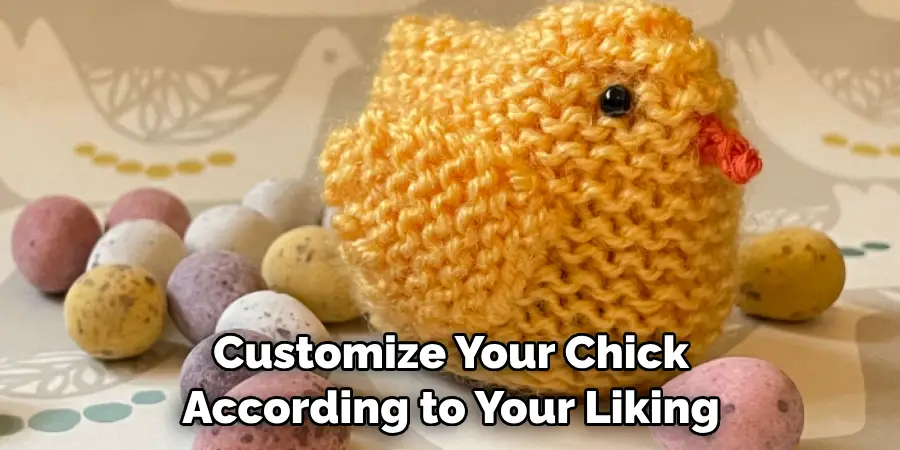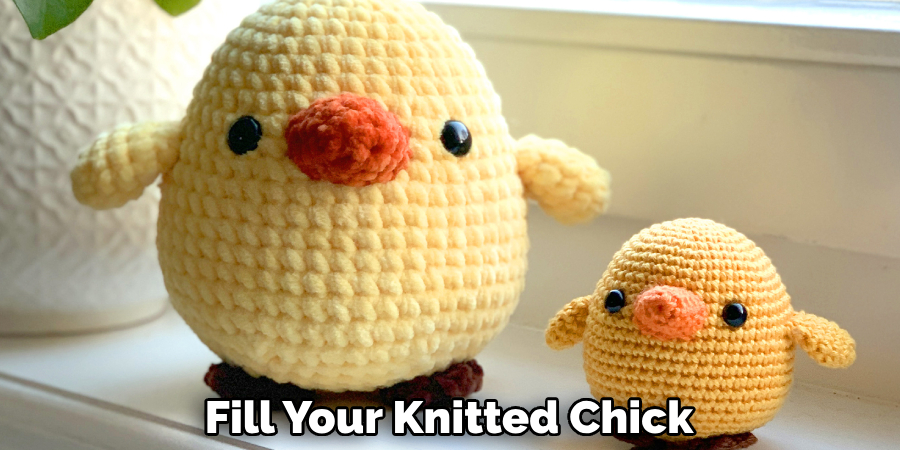Before jumping into the knitting process, it’s important to understand why you should knit a chick. Knowing how to make this beloved baby bird is incredibly rewarding and can provide hours of joy and entertainment for all ages. It will bring back fond childhood memories of crafting with your mom and help you create treasured keepsakes that can be passed down for generations.

There are many advantages to knitting a chick. It can be a fun and rewarding project for beginners and experienced knitters. It provides an opportunity to practice and refine knitting skills, and the end product is also a unique, one-of-a-kind item that you can proudly give away or keep as a cherished memento for yourself. In this blog post, You will learn how to knit a chick in detail.
Step-by-Step Processes for How to Knit a Chick
Step 1: Inspect and Gather Materials
Before knitting your chick, you must ensure all the materials are ready. Gather a pair of knitting needles, some yarn of appropriate weight and color for your project, scissors, a tapestry needle, and stitch markers.
Step 2: Cast On
Using the long-tail cast-on method, cast on the number of stitches you need for your project. This will depend on the size of your chick and the yarn weight you have chosen. Make sure that all your stitches are even. Using the knitting needles, work in a stocking stitch pattern until you reach the desired length for the chick’s body. For a standard-sized chick, you should knit around 10 cm.
Step 3: Create the Head
Once you reach the desired length for your chick’s body, use a stitch marker to mark the place where the head will be formed. Continue knitting in a stocking stitch pattern until you reach a length of approximately 5 cm. Then begin to decrease stitches at both ends so that the body of your chick is slightly tapered.

Step 4: Add the Beak
Using a tapestry needle and some yarn, stitch two small triangles to form the beak for your chick. Secure them with a few extra stitches so they stay in place. Use some black yarn to stitch two small eyes on the head of your chick. Add a few more stitches to make sure they are securely attached.
Step 5: Create the Wings
You use knitting needles, cast on 8-10 stitches, and knit in a stocking stitch pattern for around 5 cm. Then decrease one stitch at each end until only one stitch is left on the needle. Cut the yarn and thread it through the single stitch to secure it. Attach the wings to either side of your chick’s body using the tapestry needle. Ensure they are securely attached in place by stitching a few extra stitches.
Step 6: Attach Legs
Stitch two small legs to the bottom of your chick’s body using some black yarn. Secure them by stitching a few extra stitches. Finally, weave all loose ends using the tapestry needle and trim any excess yarn.
You can use different yarn colors for the wings and legs to make a more colorful chick. You could also add embroidery or other decorative details to customize your chick according to your liking.

Safety Tips for How to Knit a Chick
- Always select a chick pattern that is suitable for your skill level.
- Please take special care when handling sharp needles and scissors while knitting the chick.
- When using multiple colors, ensure all yarns are securely fastened to prevent tangling and stitch count errors.
- Make sure to read through the instructions thoroughly before starting any step.
- If you are frustrated, take a break and return to it later.
- Take extra caution when using stuffing for the chick, as it could be a choking hazard for children.
- Regularly check your knitting and ensure everything is clear from the previous steps.
You can start knitting a chick once all the safety tips have been followed. Start by selecting a pattern and gathering all the materials needed for your project.
How Can You Tell When the Chick is Finished?
When knitting a chick, knowing when it’s time to finish your work is important. The chick is complete when the stitches appear neat and even and the stuffing inside remains secure.
Additionally, be sure not to overstuff the chick, as this can cause the shape of your chick to become distorted. Lastly, check for loose ends and make sure they are all carefully tucked in. After these steps have been completed, your masterpiece should be complete.
What Types of Patterns Should Be Used for This Project?
When it comes to knitting a chick, various patterns can be used. Try a simple garter stitch pattern for those looking for a classic look. This is a great way to create an even and consistent pattern throughout the chick’s body. If you want more detail, add ribbing and cable patterns for a more intricate look.

You can also use special types of yarn to create whimsical textures or unique colors to make your chick stand out. Experiment with different patterns and find the one that works best for you.
How Do You Take Care of the Knitted Chick?
Once you have finished knitting your chick, taking proper care of it is important. To ensure the longevity and quality of your knitted chick, here are some tips on how to look after it:
- Place your knitted chick in a dry area away from direct sunlight and damp conditions. This will help prevent any fading or discoloration.
- Store your knitted chick in a room with low humidity to prevent stretching and sagging.
- Handle your knitted chick gently so as not to cause any damage or tears.
- Spot-clean the surfaces of your knitted chick using a damp cloth and gentle detergent. Do not submerge it in water.
Following these tips, you can keep your knitted chick looking as good as new for many years.
Is It Important to Keep Track of How Many Rows Have Been Completed?
When knitting a chick, keeping track of how many rows you’ve completed is important. Keep track of the rows you complete to ensure your work remains even and consistent throughout. Additionally, it helps to ensure that all pieces are knit together correctly and with the right tension.
One way to track how many rows have been completed is using a row counter. A row counter is a small tool that clips onto the side of your knitting needle and helps track how many rows have been knitted.
Alternatively, some people prefer to mark each row with stitch markers or to use a tally system. Whatever method you choose, keep track of the number of rows you knit so that your finished product looks great.
What Type of Stuffing Should You Use to Fill the Head and Body of the Chick?
You can use anything you like to fill your knitted chick. Polyfil, or pillow stuffing, is a great choice in most craft stores. Chickens are two-legged animals, so be sure to stuff the legs slightly firmer than the rest of the body if you want it to stand up on its own.

Put some stuffing in the beak and wings for a more detailed look. If you have other small pieces of fabric lying around, like buttons or pieces of yarn, you can also use those to give your chick an extra touch.
Sew the bottom closed with yarn once you’ve filled the head and body with stuffing. A simple whip stitch will do the trick here. You can also use this stitching to attach any other details you may have added, such as beaks or wings. Be sure to show off your creation and let everyone admire your work. Knitting is a great way to create something unique and special, so get creative and enjoy it.
Conclusion
In conclusion, knitting a chick is fun and rewarding, perfect for beginners and experienced knitters. The techniques used are straightforward to learn. It’s also an opportunity to create something unique, practical, and beautiful simultaneously.
Knitting your chicks will bring you much joy and satisfaction, whether it’s your first or hundredth project. I hope reading this post has helped you learn how to knit a chick. Make sure the safety precautions are carried out in the order listed.

